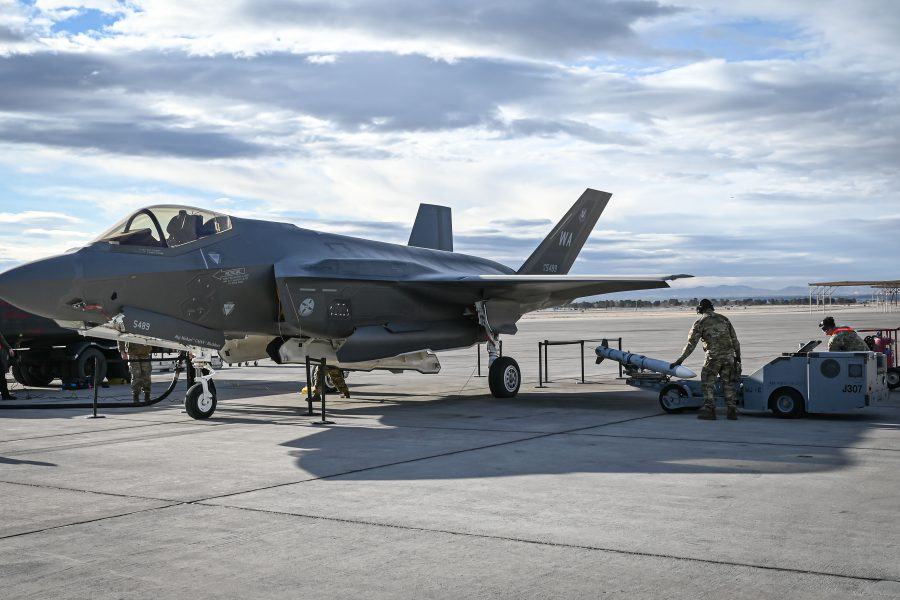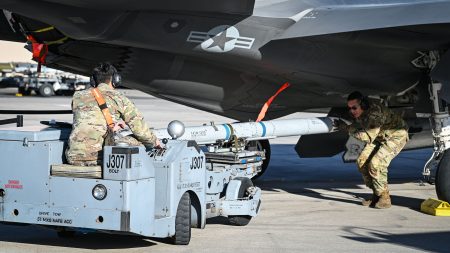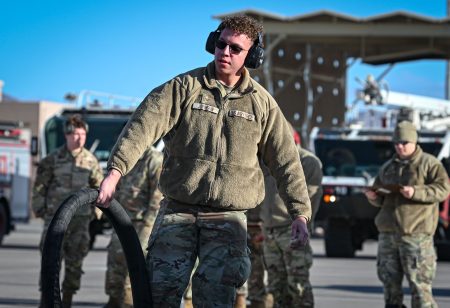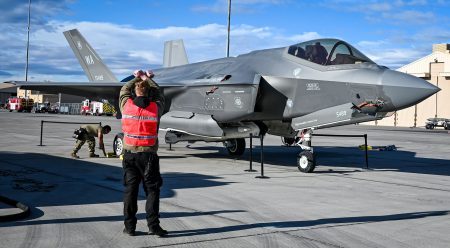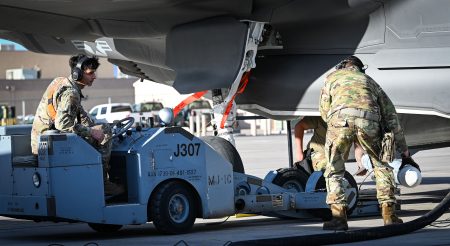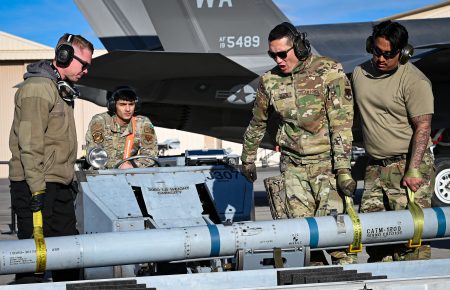Maintainers swarmed an F-35 at Nellis Air Force Base, Nev., last month, testing out a procedure that has become common for older fighters but has never been done before on the service’s fifth-generation jets: a “hot” integrated combat turn.
Hot ICTs involve simultaneously refueling and rearming a fighter with new munitions while the engines are still running. Normally it can take maintainers around three hours to prepare a single F-35 for a new sortie. A team involving half a dozen different government organizations and technicians from industry want to cut that turnaround in half and possibly get as low as 25 minutes.
The team completed its first hot ICT on an F-35A in January, a spokesperson told Air & Space Forces Magazine, though she declined to specify the exact date or whether more have taken place since then.
Regardless, the successful test is a significant milestone for the burgeoning test maintenance community.
“It’s been a long time coming,” Master Sgt. Sharlyn Smith, F-35 operational test and evaluation superintendent for the 59th Test and Evaluation squadron, told Air & Space Forces Magazine. “We did a lot of legwork to investigate all of the risks and then put a lot of time and effort into mitigating those risks down to an acceptable level to actually execute the operation. So the behind-the-scenes efforts have been going on for honestly quite a while here, and then the actual execution portion has obviously happened in the last couple of months.”
In preparing to conduct the hot ICT, the team looked at how the Marine Corps performs a similar procedure on its F-35B and C models, and how the Vermont Air National Guard conducted rearming and refueling for its F-35As.
Just as pilots must learn new skills to fly the F-35 compared to older aircraft, maintainers have to adjust their procedures, said Master Sgt. Oliver Gutierrez, F-15 and F-16 operational test and evaluation superintendent. In particular, fifth-generation fighters have internal weapons bays and more electrical systems compared to fourth-generation aircraft, he said.
“There were a lot of engineering looks we had to do to ensure that we are developing capabilities that are going to be safe to maintainers,” he said.
Along the way, test maintainers used a “crawl, walk, run” approach—testing out their ideas with the jet’s engines turned off first, for example.
“Ultimately, it is standardizing procedures and training,” Gutierrez said. “It’s a lot of training, but in order to train, we need to know what we’re doing exactly. So this is what we’re doing—we’re testing it, validating procedures, and then we’re going to go out and train with our maintainers out in the field.”
As part of that process, Smith said, the team looked at execution speed for the whole procedure but also went beyond to break down each part of a hot ICT—the rearming, refueling, and regenerating of an F-35—and study how they could be done more efficiently.
The process is one that Capt. Cameron Castleberry, head of the Maintenance Operational Test (MxOT) Division within the 59th Test and Evaluation Squadron, described as a balance between the necessary risk acceptance of the test community and the safety focus of the maintenance community.
But as Gutierrez made clear, the team doesn’t feel that they’ve reached the limit of how fast the process can be.
“We’re going to be continuously developing this tactic to refine the maintenance capabilities,” he said. “It is a unique tactic that has a lot of really fun implications for how we can get faster. We are thinking of creative solutions to get faster, but that is still in work overall. And I’ll just let you know we will not be stopping anytime soon, and we will just look to further increase our time.”
The ability to get an F-35 back up in the air as quickly as possible is something that Air Force officials know could be crucial in a potential conflict—studies have found that in a potential high-end conflict, most aircraft losses would happen on the ground.
“This test team really thought that that was going to be an important capability that we wanted to not only explore, but eventually get published and to be a common practice that we would utilize in combat when future threats take off,” Smith said.
Integrated combat turns proved important when Air Force fighters helped defend Israel against a large-scale Iranian attack last year—one F-15E expended all its munitions taking down drones, then landed and got ready to go again in roughly 30 minutes, taking off before missiles and debris started raining down on the base.
